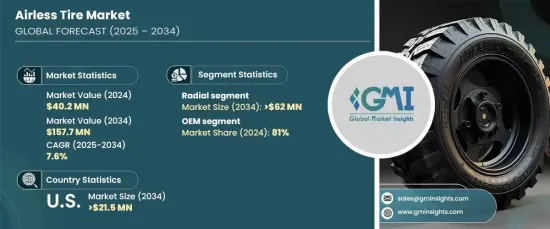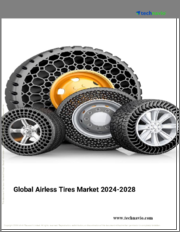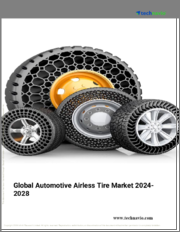
|
시장보고서
상품코드
1667182
에어리스 타이어 시장 : 기회, 성장 촉진요인, 산업 동향 분석, 예측(2025-2034년)Airless Tire Market Opportunity, Growth Drivers, Industry Trend Analysis, and Forecast 2025 - 2034 |
||||||
세계의 에어리스 타이어 시장은 2024년에 4,020만 달러로 평가되었고 2025년부터 2034년에 걸쳐 CAGR 7.6%로 성장할 것으로 예상되고 있습니다.
에어리스 타이어는 펑크, 누출, 날아가는 등 기존의 공기 타이어가 직면했던 문제를 해결하는 능력으로 인기를 끌고 있습니다. 내구성이 뛰어나 메인터넌스 프리 설계이기 때문에 건설, 농업, 방위 등 가혹한 환경에서 조업하는 산업에 최적입니다. 가동 중지 시간을 최소화하고 유지 보수 비용을 낮추면 에어리스 타이어는 함대 운영자와 개인 소비자 모두에게 비용 효율적이고 안정적인 솔루션을 제공합니다.

첨단 폴리머의 통합이나 3D 프린팅의 채용 등, 재료나 제조 공정에 있어서의 기술적 진보가 에어리스 타이어의 진화를 뒷받침하고 있습니다. 이러한 기술 혁신으로 내하중성, 충격 흡수성, 종합 성능이 향상되어 상용차 및 승용차용 매력이 높아지고 있습니다. 핸들링 성능이 향상되고 내구성이 향상됨에 따라 에어리스 타이어는 기존의 대안을 대체하는 현실적인 선택이 되고 있으며, 시장 침투를 더욱 뒷받침하고 있습니다.
| 시장 범위 | |
|---|---|
| 시작 연도 | 2024 |
| 예측 연도 | 2025-2034년 |
| 시작 금액 | 4,020만 달러 |
| 예측 금액 | 1억 5,770만 달러 |
| CAGR | 7.6% |
시장 세분화에서는 레이디얼 에어리스 타이어가 시장을 독점하고 있으며 2034년까지 6,200만 달러를 창출할 것으로 예측됩니다. 타이어의 진행 방향에 수직으로 늘어선 프라이 코드를 특징으로 하는 뛰어난 설계는 노면과의 접지성과 트랙션을 강화하여 핸들링의 향상과 부드러운 승차감을 가져다줍니다. 레이디얼 타이어는 열 축적 감소, 트레드 수명 연장, 연비 개선 등의 이점도 있어 승용차, 버스, 트럭 등 다양한 차량 카테고리에서 선호되고 있습니다.
시장은 판매 채널별로 OEM과 애프터마켓으로 구분되며, 2024년 점유율은 OEM이 81%를 차지했습니다. OEM용 에어리스 타이어는 자동차 제조업체의 특정 성능, 안전 및 내구성 기준을 충족하도록 조정되어 서스펜션 및 브레이크와 같은 중요한 시스템과 최적의 호환성을 보장합니다. 이러한 자동차 및 타이어 제조업체의 협력 체제가 기술 혁신을 촉진하고 우수한 품질을 보장하는 것이 시장에서 OEM의 우위에 기여하고 있습니다.
미국의 에어리스 타이어 시장은 2024년에 84%의 점유율을 차지했으며, 2034년에는 2,150만 달러에 이를 것으로 예측됩니다. 이 나라는 자동차 부문이 확립되어 자동차 보유율이 높고 인프라가 확고하기 때문에 여러 용도로 에어리스 타이어 수요가 큽니다. 게다가 기술 혁신에 중점을 두어 효율성, 안전성, 환경의 지속가능성을 중시하는 이 지역에 따른 선진적인 타이어 솔루션의 개발이 진행되고 있습니다. 이러한 요인으로 인해 미국은 에어리스 타이어의 주요 시장이 되었습니다.
목차
제1장 조사 방법과 조사 범위
- 조사 디자인
- 조사 접근
- 데이터 수집 방법
- 기본 추정과 계산
- 기준연도의 산출
- 시장추계의 주요 동향
- 예측 모델
- 1차 조사와 검증
- 1차 정보
- 데이터 마이닝 소스
- 시장 정의
제2장 주요 요약
제3장 업계 인사이트
- 생태계 분석
- 기술 제공업체
- 부품 공급자
- 제조업체
- OEM 제조업체
- 공급자의 상황
- 이익률 분석
- 기술 혁신의 상황
- 주요 뉴스와 대처
- 규제 상황
- 영향요인
- 성장 촉진요인
- 내구성이 높고 유지 보수가 필요없는 타이어에 대한 수요 증가
- 타이어 제조 기술의 진보
- 전기자동차와 자율주행차의 채용 증가
- 지속가능성과 환경에 대한 관심 증가
- 업계의 잠재적 위험 및 과제
- 높은 도입 비용
- 엄격한 규제
- 성장 촉진요인
- 성장 가능성 분석
- Porter's Five Forces 분석
- PESTEL 분석
제4장 경쟁 구도
- 서론
- 기업 점유율 분석
- 경쟁 포지셔닝 매트릭스
- 전략 전망 매트릭스
제5장 시장 추계·예측 : 제품별(2021-2034년)
- 주요 동향
- 방사형
- 편향성
제6장 시장 추계·예측 : 소재별(2021-2034년)
- 주요 동향
- 고무
- 플라스틱
제7장 시장 추계·예측 : 차량별(2021-2034년)
- 주요 동향
- 군용차
- 승용차 및 상용차
- 지형 차량
- 유틸리티 차량
- 이륜차
- 로봇
제8장 시장 추계·예측 : 판매 채널별(2021-2034년)
- 주요 동향
- OEM
- 애프터마켓
제9장 시장 추계·예측 : 지역별(2021-2034년)
- 주요 동향
- 북미
- 미국
- 캐나다
- 유럽
- 영국
- 독일
- 프랑스
- 스페인
- 이탈리아
- 러시아
- 폴란드
- 아시아태평양
- 중국
- 인도
- 일본
- 한국
- 뉴질랜드
- 동남아시아
- 라틴아메리카
- 브라질
- 멕시코
- 아르헨티나
- 중동 및 아프리카
- UAE
- 남아프리카
- 사우디아라비아
제10장 기업 프로파일
- Amerityre
- Bridgestone Corporation
- Cheng Shin Rubber Industry Co. Ltd.
- Continental AG
- Hankook Tire &Technology Co. Ltd.
- Linglong Group Co. Ltd.
- Michelin Group
- Resilient Technologies
- Sumitomo Rubber Industries
- Tannus America LLC
- The Goodyear Tire &Rubber Company
- The Yokohama Rubber Co. Ltd.
- Toyo Tires
The Global Airless Tire Market, valued at USD 40.2 million in 2024, is expected to grow at a CAGR of 7.6% from 2025 to 2034. Airless tires are gaining traction due to their ability to address issues faced by traditional pneumatic tires, such as punctures, leaks, and blowouts. Their durable, maintenance-free design makes them ideal for industries operating in demanding environments, including construction, agriculture, and defense. By minimizing downtime and lowering maintenance costs, airless tires offer a cost-effective and reliable solution for both fleet operators and individual consumers.

Technological advancements in materials and manufacturing processes, such as the integration of advanced polymers and the adoption of 3D printing, are driving the evolution of airless tires. These innovations have improved load-bearing capacity, shock absorption, and overall performance, enhancing their appeal for commercial and passenger vehicles. With better handling capabilities and increased durability, airless tires are becoming a viable alternative to traditional options, further boosting their market penetration.
| Market Scope | |
|---|---|
| Start Year | 2024 |
| Forecast Year | 2025-2034 |
| Start Value | $40.2 Million |
| Forecast Value | $157.7 Million |
| CAGR | 7.6% |
In terms of product segmentation, radial airless tires dominate the market and are projected to generate USD 62 million by 2034. Their superior design, characterized by ply cords aligned perpendicular to the tire's direction of travel, enhances road contact and traction, resulting in better handling and a smoother ride. Radial tires also offer benefits like reduced heat buildup, extended tread life, and improved fuel efficiency, making them a preferred choice across various vehicle categories, including passenger cars, buses, and trucks.
The market is segmented by sales channels into OEM and aftermarket, with the OEM segment accounting for a significant 81% share in 2024. OEM airless tires are tailored to meet the specific performance, safety, and durability standards of vehicle manufacturers, ensuring optimal compatibility with critical systems like suspension and braking. This collaboration between automakers and tire manufacturers drives innovation and ensures superior quality, contributing to the dominance of OEMs in the market.
U.S. airless tire market held an 84% share in 2024 and is anticipated to reach USD 21.5 million by 2034. The country's well-established automotive sector, high vehicle ownership rates, and robust infrastructure drive significant demand for airless tires across multiple applications. Additionally, a strong emphasis on technological innovation has led to the development of advanced tire solutions, aligning with the region's focus on efficiency, safety, and environmental sustainability. These factors position the U.S. as a key market for airless tires.
Table of Contents
Chapter 1 Methodology & Scope
- 1.1 Research design
- 1.1.1 Research approach
- 1.1.2 Data collection methods
- 1.2 Base estimates and calculations
- 1.2.1 Base year calculation
- 1.2.2 Key trends for market estimates
- 1.3 Forecast model
- 1.4 Primary research & validation
- 1.4.1 Primary sources
- 1.4.2 Data mining sources
- 1.5 Market definitions
Chapter 2 Executive Summary
- 2.1 Industry synopsis, 2021 - 2034
Chapter 3 Industry Insights
- 3.1 Industry ecosystem analysis
- 3.1.1 Technology providers
- 3.1.2 Component suppliers
- 3.1.3 Manufacturers
- 3.1.4 OEMs
- 3.2 Supplier landscape
- 3.3 Profit margin analysis
- 3.4 Technology & innovation landscape
- 3.5 Key news & initiatives
- 3.6 Regulatory landscape
- 3.7 Impact forces
- 3.7.1 Growth drivers
- 3.7.1.1 Rising demand for durable and maintenance-free tires
- 3.7.1.2 Advancements in tire manufacturing technology
- 3.7.1.3 Increasing adoption of electric and autonomous vehicles
- 3.7.1.4 Focus on sustainability and environmental concerns
- 3.7.2 Industry pitfalls & challenges
- 3.7.2.1 High implementation costs
- 3.7.2.2 Stringent regulations
- 3.7.1 Growth drivers
- 3.8 Growth potential analysis
- 3.9 Porter’s analysis
- 3.10 PESTEL analysis
Chapter 4 Competitive Landscape, 2024
- 4.1 Introduction
- 4.2 Company market share analysis
- 4.3 Competitive positioning matrix
- 4.4 Strategic outlook matrix
Chapter 5 Market Estimates & Forecast, By Product, 2021 - 2034 ($Mn, Units)
- 5.1 Key trends
- 5.2 Radial
- 5.3 Bias
Chapter 6 Market Estimates & Forecast, By Material, 2021 - 2034 ($Mn, Units)
- 6.1 Key trends
- 6.2 Rubber
- 6.3 Plastic
Chapter 7 Market Estimates & Forecast, By Vehicle, 2021 - 2034 ($Mn, Units)
- 7.1 Key trends
- 7.2 Military vehicle
- 7.3 Passenger & commercial vehicle
- 7.4 Terrain vehicle
- 7.5 Utility vehicle
- 7.6 Two-wheelers
- 7.7 Robotics
Chapter 8 Market Estimates & Forecast, By Sales Channel, 2021 - 2034 ($Mn, Units)
- 8.1 Key trends
- 8.2 OEM
- 8.3 Aftermarket
Chapter 9 Market Estimates & Forecast, By Region, 2021 - 2034 ($Mn, Units)
- 9.1 Key trends
- 9.2 North America
- 9.2.1 U.S.
- 9.2.2 Canada
- 9.3 Europe
- 9.3.1 UK
- 9.3.2 Germany
- 9.3.3 France
- 9.3.4 Spain
- 9.3.5 Italy
- 9.3.6 Russia
- 9.3.7 Poland
- 9.4 Asia Pacific
- 9.4.1 China
- 9.4.2 India
- 9.4.3 Japan
- 9.4.4 South Korea
- 9.4.5 ANZ
- 9.4.6 Southeast Asia
- 9.5 Latin America
- 9.5.1 Brazil
- 9.5.2 Mexico
- 9.5.3 Argentina
- 9.6 MEA
- 9.6.1 UAE
- 9.6.2 South Africa
- 9.6.3 Saudi Arabia
Chapter 10 Company Profiles
- 10.1 Amerityre
- 10.2 Bridgestone Corporation
- 10.3 Cheng Shin Rubber Industry Co. Ltd.
- 10.4 Continental AG
- 10.5 Hankook Tire & Technology Co. Ltd.
- 10.6 Linglong Group Co. Ltd.
- 10.7 Michelin Group
- 10.8 Resilient Technologies
- 10.9 Sumitomo Rubber Industries
- 10.10 Tannus America LLC
- 10.11 The Goodyear Tire & Rubber Company
- 10.12 The Yokohama Rubber Co. Ltd.
- 10.13 Toyo Tires


















